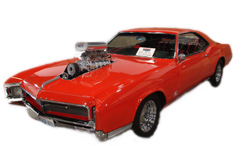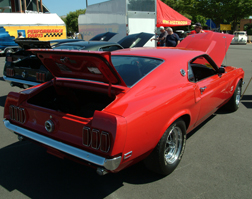"... there is no substitute
for cubic inches and no replacement for displacement"
Muscle Car Club
Muscle Cars
The
Muscle Car Club welcomes us to a
"celebration of an
era when the number of cubic inches was more important than the
number of cupholders, and quarter mile times meant more than inches
of ground  clearance." clearance."
A healthy celebration indeed, with prices for the high
quality vehicles creeping toward the $200,000 mark. The rarest
vintage 1965–1972 muscle cars can cost as much as US$500,000 (for
certain original models and options) and possibly more depending on
availability, demand, and condition of the vehicle.
In 1969, for example, who would have thought the Dodge Daytona
426 Hemi you just bought would ever be worth a whopping
$177,950?
Or how about that 1969 Chevrolet Camaro Yenko 427 ... does it
make you sick to think that if you had hung onto it and kept it
garaged for the next 35 years, it could be worth as much as
$150,400?
Indeed, these prices were quoted in the October 2005 issue of
Muscle Car Review. According to the Muscle Car Club, all
muscle cars are inherently valuable, reflecting "a time long
ago when sheer performance mattered more than cupholders and
reputations were created and destroyed on the drag strip and at
streetlights across the nation."
Description Of Muscle
Cars
The Pontiac GTO is widely considered the first
true muscle car.
During the era, print media usually referred to this class
of vehicle as "supercars". The term "muscle car" did
not become common until after production of the cars had
essentially ended, taking hold by the early to mid-1980s.
A classic muscle car is usually made in the U.S. or Australia
between 1964 and 1975. Models considered muscle cars were
primarily built in the United States, Australia and South
Africa.
 The term generally describes a 2-door rear wheel
drive mid-size car with a large, powerful V8 engine and
special trim. They were intended for maximum torque on the
street or in drag racing competition. A muscle car is an
affordable, medium weight automobile with a high horse power
engine, capable of accelerating fast. The term generally describes a 2-door rear wheel
drive mid-size car with a large, powerful V8 engine and
special trim. They were intended for maximum torque on the
street or in drag racing competition. A muscle car is an
affordable, medium weight automobile with a high horse power
engine, capable of accelerating fast.
One caveat to the weight-rule is earlier vehicles. Heavier
cars were the norm before performance-oriented intermediate
size cars started to appear in 1964. Until
the mid-1960s, manufacturers added extra performance
to full-sized vehicles.
Early full-size performance vehicles, such as Chevrolet
Impala SS, and Ford Galaxie with 390 + cid
engines, are considered muscle cars.
Which Cars Are NOT Muscle
Cars?
Cost and weight were a factor. Luxury vehicles with performance
engines and options, such as the Pontiac Grand Prix, are not
considered muscle cars due to their heavy weight and high sticker
prices, which go against the low cost performance definition
of muscle cars.
Sports cars are not considered muscle cars. Sports
cars were customarily smaller, two-seat cars, or GTs,
two-seat or 2+2 cars intended for high-speed touring, and possibly
road racing. Due to their high price and specialty nature, high
performance sports cars such as the Chevrolet Corvette are not
considered muscle cars.
The "regular" production vehicles are generally not considered
muscle cars, but rather, only the high performance version based
upon them, such as the Oldsmobile 442.
| 
















